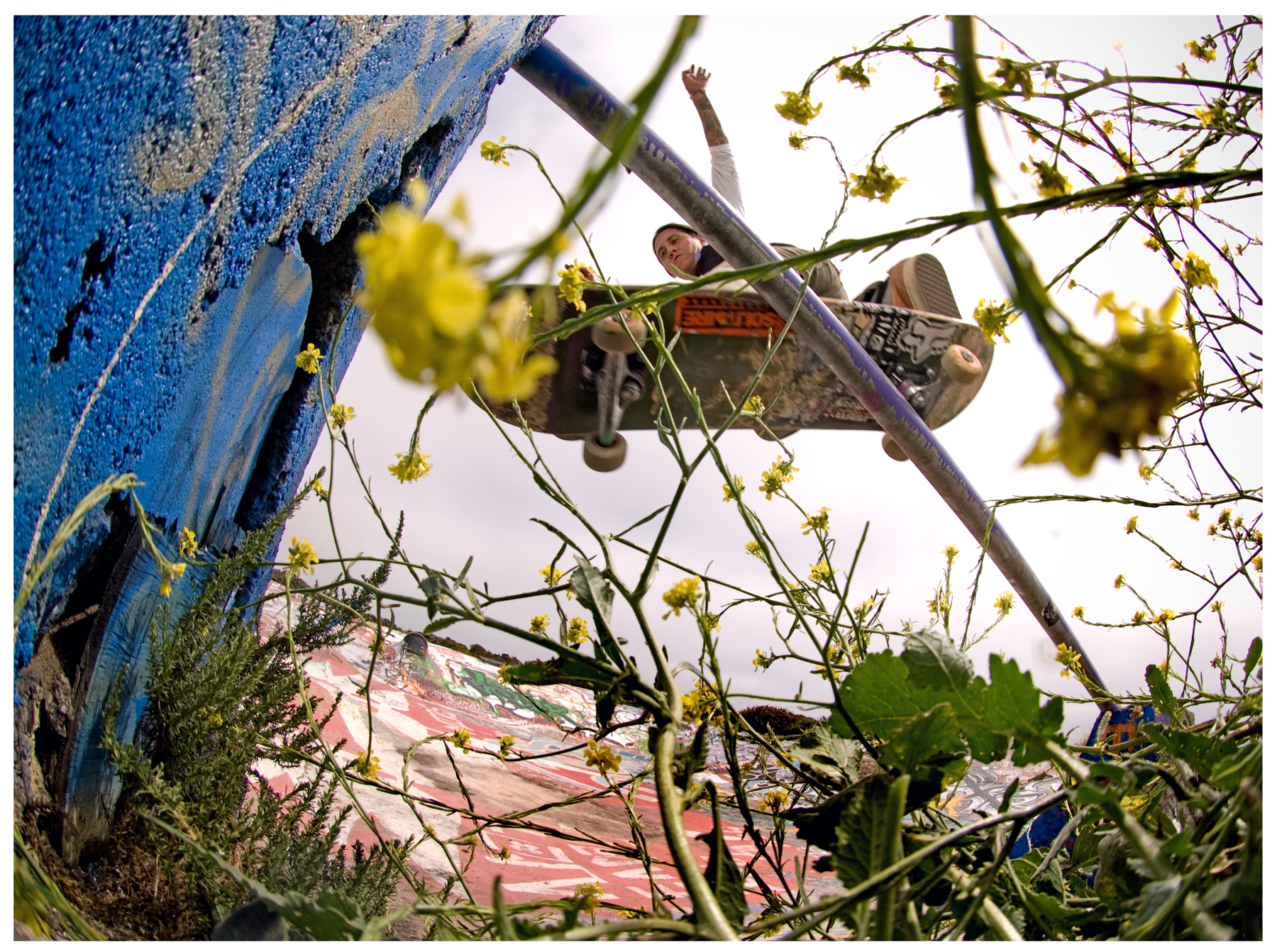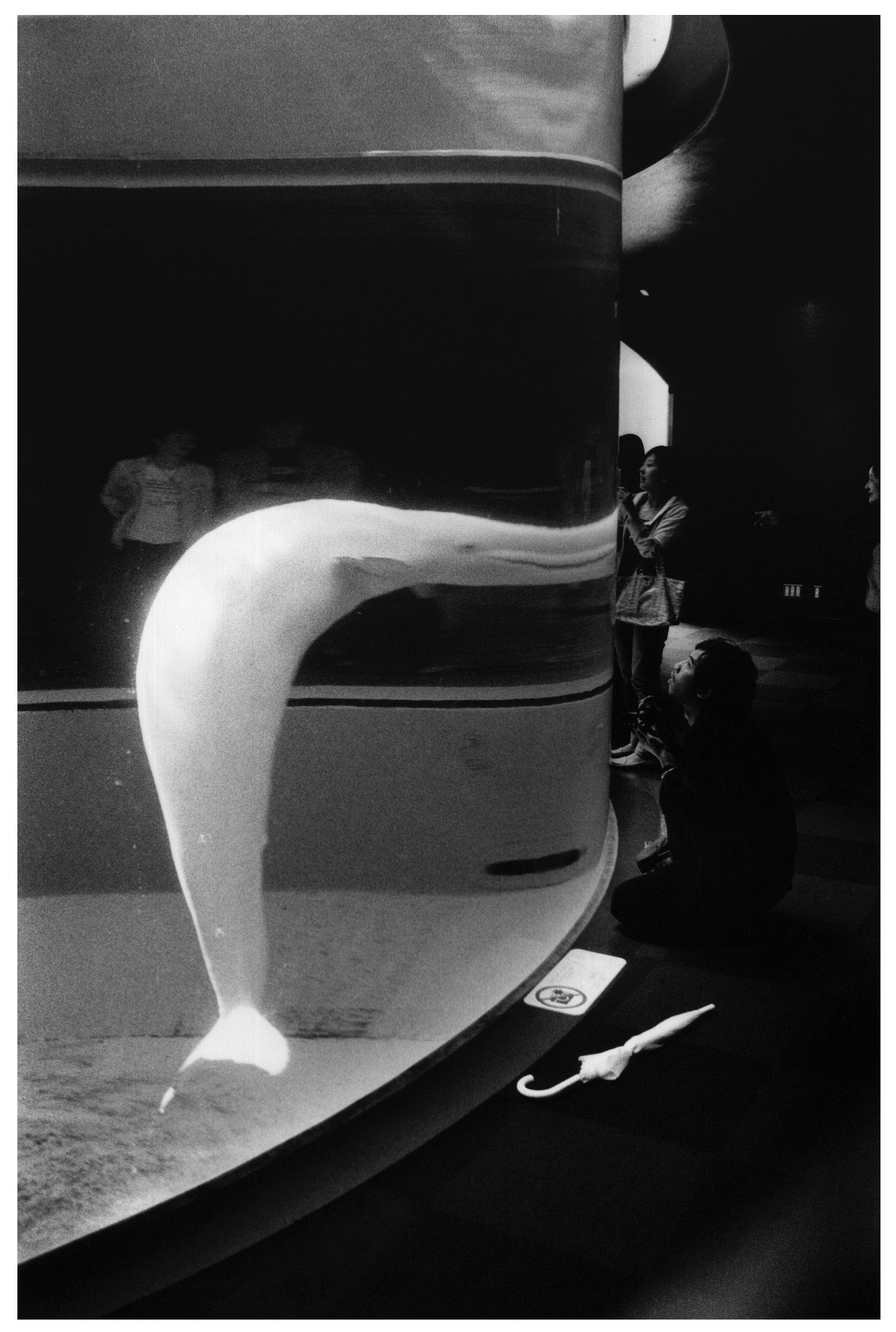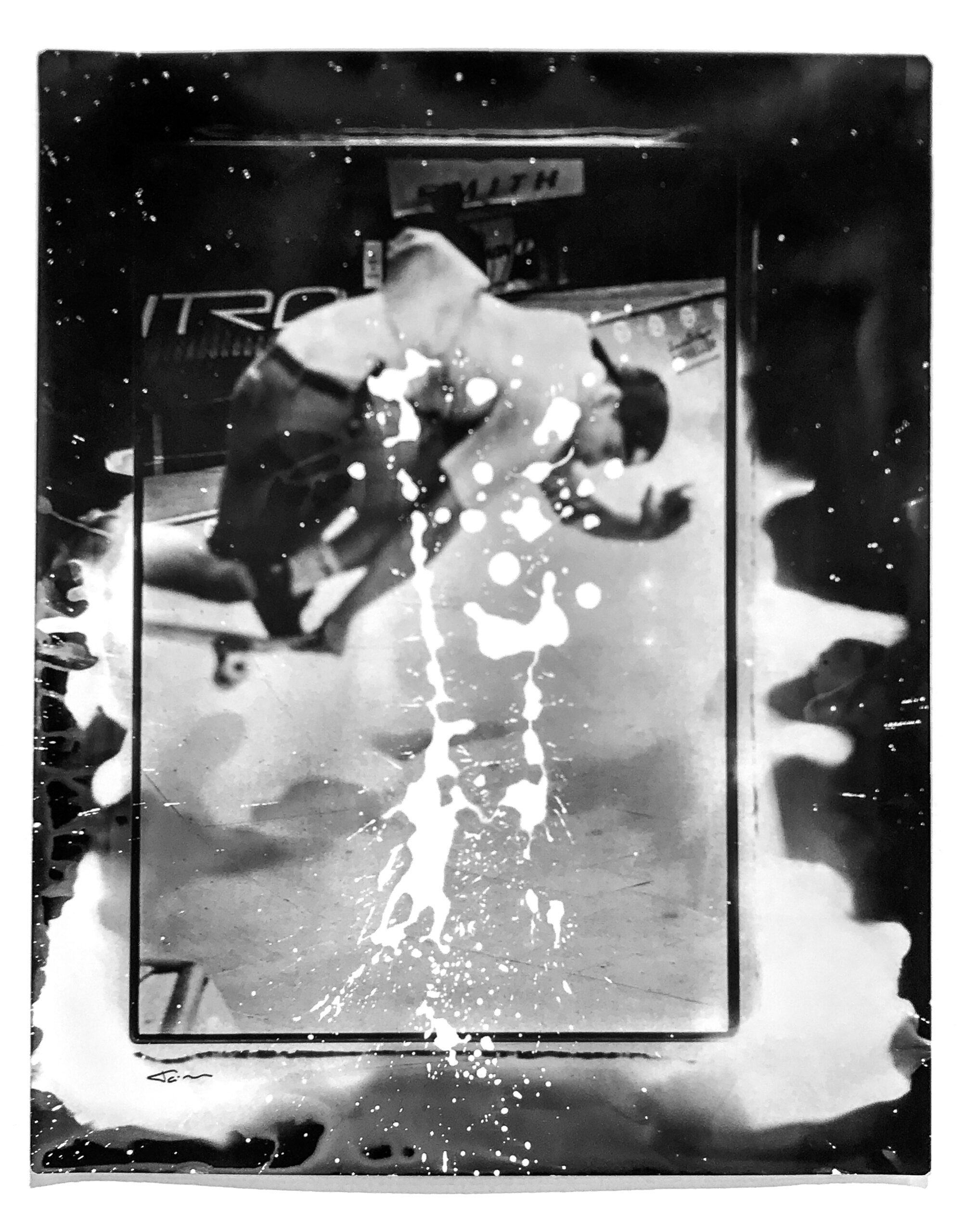In the previous installment, I wrote about Joe Brook, a chatty and smiley photographer with a camera hanging from his shoulder. Jai Tanju is very close with him, and they go on trips together to take photos and such. He’s someone who smiles quietly and writes poetically, with a camera hanging on his shoulder. Rather than expressing himself through only photography, Jai also makes collages and artworks using skateboard pieces and writes words on top of his photos.
Behind his inclinations are the influence of his way of thinking and being.
©Jai Tanju
Focusing on Jai Tanju himself, more than his photography
Jai Tanju is a skater, gallery owner, and photographer residing in San Jose. As somewhat of a late bloomer, he contributed to popular American skate culture media such as Slap, Skateboarder, Thrasher, and Juxtapoz.
In this installment, I don’t want to introduce only one side of him.
Allow me to say this now: I think of him as a poet. I’ve just met him a handful of times, but I also consider him an old friend or a mentor-like figure.
I bought Jai’s photo at No. 12, a now-gone small gallery in Tokyo, back in 2006. It was of a kid doing a wheelie on a bicycle. Jai probably has no idea, but his existence has played an immense role in shaping my thoughts and ideas. Whenever I work on a new project or feature for skate magazines, the first thing that comes to mind is him.
I would wonder, “How would Jai feel about this situation? What kind of photos would he take of skating in the city? From what angle is he trying to be involved in the current skate scene? When he hears the word, ‘photogenic,’ who would he want to shoot the most?”
Jai writes words on top of his photos, just as much as he takes film photography. It’s not like he writes descriptions that ruin the work. His words are a part of his photos, and they make the viewer think about and associate many things. They exude Jai’s emotions and philosophy towards life. It’s not like he’s trying to agitate or force anything, nor is he trying to enlighten or guide anyone. His words are his soul.
So, when he contributes to a feature, it becomes something honest with no lies. I can communicate what I want through it. This relates to how society as a whole doesn’t understand skating; there’s a massive difference between thinking about life through skating and not. At the very least, Jai’s photos and words capture skate life itself, unlike people cosplaying as skaters on YouTube and so on. I don’t want there to be any misunderstandings, but I also don’t feel like arguing which is better at this juncture.
©Jai Tanju
The elephant as a metaphor
I met him for the first time before I started Sb Skateboard Journal, a skate magazine. More than 20 years ago. Jai was on a skate tour, and I joined him as he went around the city to shoot. It was hard to convey my intentions to him with my subpar English, but there never was a bad vibe in the air. This is mainly thanks to him as a person, as he enjoys taking photos and developing them (a trait that all the photographers I’ve written about have in common, something I’d like everyone to understand).
Not only that, but he also travels with his friends or family with a skateboard, camera, and tent. And he doesn’t rush things. Jai had a relaxed calmness about him, a quality that felt almost imbalanced with skate shoots, which are usually temporary and sketchy. His existence is like a compass for the spreads I work on, such as Sb, which I mentioned before, and FAT Magazine.
I’d like to explain why I like him so much as a person, aside from his photography.
I can’t lay out many reasons, but I have a few that are clear. To begin with, don’t we like things, not due to various reasons but clear reasons?
Here’s an anecdote about his photos and words. It has to do with when he read The End of the Game, an art photography book by Peter Beard. A photo of the remains of elephants taken from an airplane, dry husks lying on the desert sand under the burning hot sun, a mountain of bones wrapped in a dried-up blanket. When he saw this, he thought of himself. He didn’t identify with the female leader of the pack. He related to an elephant a few feet away from the center and an elephant with a broken tusk. Society tells us that winning is everything, that we must compete. In contrast to this, Jai’s rational way of thinking is telling.
©Jai Tanju
Film photos, letters, stamps—a nostalgic, authentic side
The ice age of film photography arrived when digital photography was introduced. How Jai reacted at the time is memorable. Like a squirrel gathering nuts in preparation for winter, he stocked up on rolls of film. But when the proverbial ice age won, he felt something akin to the dead elephants in Peter Beard’s pictures—like an elephant lying in the desert, surrounded by flies. However, he didn’t sulk or grow bitter. He continued to shoot on film at his own pace and had fun taking documentary-style photos. He interacted with skaters all over the world and slowly, calmly built his work. Jai then realized there were new seeds of trees growing on what he thought was a rotten carcass of a photographer. Each time he found another seed, the curiosity he felt when he first held a camera and his passion for skating motivated him. This is my favorite anecdote of his.
The Print Exchange Program is something Jai continues to do, as though it were his life’s work. He communicates with people all over the globe by trading pictures with stamps on them. Photos, not postcards, get sent to his San Jose gallery from different countries. Photographers I know also exchange pictures with Jai. Unknown skaters, photo enthusiasts, and well-known photographers like Dennis McGrath, Ari Marcopoulos, and Joe Brook partake in this.
I like how when it comes to Jai, or his sensibilities, to be more specific, factors such as fame, notoriety, wealth, and business all vanish. No matter what you do with Jai, I feel like those who don’t love photography, skating, and life won’t be drawn to him. Ultimately, it might not be something that society can appreciate, but that’s fine and expected. One day, we’ll all become corpses lying on the sand that is society anyway.
©Jai Tanju
An idyllic place, faraway from phoniness
This might sound weird; I like that Jai likes Abe-chan (Takeshi Abe), my friend and a photographer who I like too. Jai calls him Abe, as though he were calling his old, beloved dog Frida, and hosts exhibitions with him in San Jose. Because Abe-chan is also a man of few words, I imagine them taking photos on their film cameras while smiling, instead of exchanging words. There’s no doubt they would then look at their developed negative film in a dark room a few days later and smile once more.
Some readers might think, “Huh, this guy’s just a weirdo.” The biggest reason is because of the lack of my writing skills, but at the same time, I genuinely can’t help but love their photos and skating. If skating were an athletic sport, then both Abe-chan and Jai probably wouldn’t do it. They probably started doing it because it’s a confusing yet fun ride. The passion for photography and cameras, born from that unpredictability and mystery, leads to work and becomes a business tool. Isn’t that why they get so driven? That’s why it makes me happy to know that Abe-chan and Jai met and linked up.
By the way, everyone calls him Jai. This will be familiar territory for Japanese people: when people hear Jai, they think of the big bully, Takeshi Gouda a.k.a Gian, from the anime series Doraemon. But for us in the skate world, when we say Jai, we mean Jai Tanju—not just in America but Japan too. And Jai isn’t an unreasonable person who claims to be the leader of a pack like Gian. He’s the polar opposite. He thoroughly understands the unreasonableness of people and the times, but he continues to skate, love his family, and enjoy shooting without compromise. He’s a part of San Jose, and San Jose is a part of him.
In the future, when I come up with more features, I’d like to keep referring to Jai for inspiration. One day, I want to make a book with his photography and writing. I’m especially interested in his current method, where he makes collages out of contact sheets to convey an image and message (word contact sheet). Once this turns into a book, I believe it’d become something that no one would forget, even if the future is an even more decayed digital society. It’d be like the remains of an elephant in the desert forever carrying its echoes. I’ve secretly been wanting to make this offer to him.
This conclusion has turned into something very personal, but it would make me happy if Jai reads this with a grin.
©Jai Tanju
Jai Tanju
Jai Tanju is a photographer based in San Jose, America. He has put out many works and actively hosts both solo and group shows. He got his start in showing his skate photos in Slap, the sister skate magazine of Thrasher. He has also established friendships with Dennis McGrath and Joe Brook, who have been written about in this series. His unique works are available for purchase at https://booksbyjai.bigcartel.com/.
Instagram: @iajujnat
Translation Aya Apton






